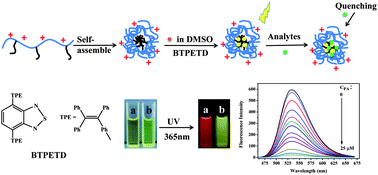Fluorescent micelles based on hydrophobically modified cationic cellulose for sensing trace explosives in aqueous solutions
Abstract
Amphiphilic cationic cellulose derivatives with different long alkyl chains as hydrophobic segments were synthesized. They can self-assemble into cationic micelles in distilled water. The structure and properties of the micelles were characterized by elemental analysis, FT-IR, 1H NMR, ζ-potential measurements, DLS, TEM, and fluorescence spectroscopy. The hydrophobic cores of the micelles were used to load a hydrophobic dye (4,7-bis[4-(1,2,2-triphenylvinyl)phenyl]benzo-2,1,3-thiadiazole, BTPETD) and exhibited a stable photoluminescence. The fluorescence emission can quantitatively and sensitively respond to 2,4-dinitrophenol (DNP) and picric acid (PA) due to the electron transfer between BTPETD and the explosives, and the limit of detection was 200 and 50 nM for DNP and PA, respectively. The novel hydrophobically modified cationic cellulose micelles have the potential to prepare feasible, sensitive and stable sensor systems for detecting explosives in aqueous solutions.


 Please wait while we load your content...
Please wait while we load your content...